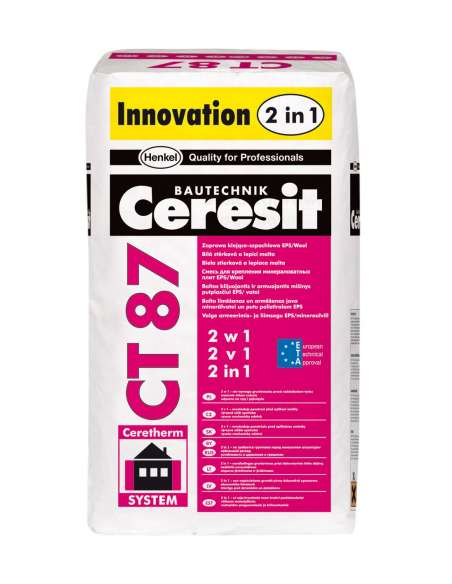- “2 in 1” – does not need priming before the application of plaster, white colour
- Considerably lower consumption
- High adhesion to mineral substrates, EPS and wool
- Vapour permeable
- Flexible and reinforced with fibres
- Resistant to weather conditions, hairlines and cracks
- Amount required:
- Fixing of EPS-boards: approx. 4.0 kg/m2
- Reinforced layer (on EPS-boards): approx. 3.0 kg/m2
- Fixing of mineral wool boards: approx. 4.5 kg/m2
- Reinforced layer (on mineral wool): approx. 4.0 kg/m2
CT 87 - white, vapor permeable and flexible mortar for fixing polystyrene and mineral wool boards and for applying a reinforced layer. Thanks to decreased absorbency, increased flexibility and the adhesion to plaster, it does not require priming before application of the thin-coat plaster. Special light fillers improve the workability. Use of the mortar accelerates and facilitates the application of ETICS (1 or 2 days shorter) and reduces square meter costs of the system.
Ceresit CT 87 mortar is designed to insulate external walls of the buildings by application of external thermal insulation composite system using EPS- or mineral wool façade boards. It is an element of following ETICS from Ceresit Ceretherm Premium, Express and Wool Premium. CT 87 mortar is used for fixing of EPS- or mineral wool façade boards and for applying the reinforcing protection layer to insulate the newly constructed objects as well as older buildings to be thermo-re- novated. Ceresit CT 87 is additionally reinforced with fibres, therefore it is more resistant to the formation of cracks and hairlines. The application of CT 87 (colour, surface and orga- nic modifiers) allows for omitting the substrate preparation process by priming with the priming paints before the appli- cation of any Ceresit plasters. The content of special light fillers gives the more flexible, light and homogenous con- sistency, it is easier to be stirred, applied and spread, thus increasing the efficiency of the mortar.
1. Fixing thermal insulation boards CT 87 mortar shows good adhesion to carrying, compact and dry substrates, such as surfaces of walls, plasters, mo- saics and concretes free from grease, bitumen, dust and other substances decreasing adhesion. The adhesion to the existing plasters and paint coatings should be checked before starting the application. ‘’Hollow’’ plasters should be removed. Any losses and uneven surfaces of the substrate below 20 mm should be filled with the Ceresit CT 29 filler, or Ceresit CT 24 insulating plaster, or covered with cement plaster. Any sur- face contaminant and other adhesion impairing substances, steam-tight paint coatings and the coats with low adhesion to the substrate should be completely removed, e.g. by means of washing devices operating under pressure. In case of my- cological contamination with fungi, moss and algae, the sur- face of the façade should be cleaned with steel brushes and, then saturated with Ceresit CT 99 fungicide solution in com- pliance with the technical data sheet. The old, not plastered walls, strong plasters and paint coats should be de-dusted, then washed with water jet and left until they go completely dry. Substrates with high water absorption, e.g. walls made of aerated concrete blocks or silicate blocks should be primed with Ceresit CT 17 and left for drying for at least four hours. Adhesion of Ceresit CT 87 to the prepared substrate is checked by gluing 10 x 10cm blocks of EPS-boards in a few places and pulling off manually after 4 ÷ 7 days. The load carrying ability of the substrate is sufficient only when the EPS-boards are subject to rent.
2. Armoured layer application. When CT 87 is set (after approx. 2 days), any unevenness of the boards should be ground with abrasive paper, then any loose particles of insulation materials should be carefully brushed whereas the boards should be additionally reinfor- ced with mechanical anchors. If EPS-boards have not been covered with the armoured layer for 2 weeks, then their qua- lity should be evaluated. The yellowed boards with dusting surface should be ground with coarse abrasive paper.
CT 87 should be poured into the measured amount of cool clean water and stirred with the drill by means of a mixer until the homogenous mass is obtained without lumps.
1. Fixing thermal insulation boards. The ready mortar should be applied with a trowel along the board edge forming a strip of 3÷4 cm wide and a few spots with the diameter of approx. 8 cm. Only in case of mineral wool boards, it is necessary to apply so called ‘’priming’’ with CT 87 on the whole surface of the board with the use of a metal long float before the adhesive mortar is applied. Then immediately, the board should be pressed to the wall with a few slight blows of a long float. The properly applied mortar when pressed should cover minimum 40 % of its sur- face. In case of even, smooth substrates the mortar should be applied by means of a toothed long float (teeth 10–12 mm). The boards should be fixed tightly one at the other in one sur- face with the preservation of ”brick like manner’’ of vertical connection.
2. Armoured layer application. The ready mortar should be spread along the surface of the boards by means of a toothed long float with the size of the teeth 10-12mm. Only in case of mineral wool boards, it is necessary to apply so called ‘’priming’’ with CT 87. The glass fibre mesh should be applied on the fresh mortar, it should be immersed by means of a metal long float and filled smoothly. The properly immersed glass fibre should not be visible, it should be completely immersed in the adhesive mortar. It is ne- cessary to use the approximately 10-cm overlaps of the neigh- bouring mesh belts. Fresh stains should be cleaned with water while hardened elements should be mechanically removed.
- Model
- CT87
- Usage/Coverage
- 4.0 kg/m2
- Size
- 25 kg








